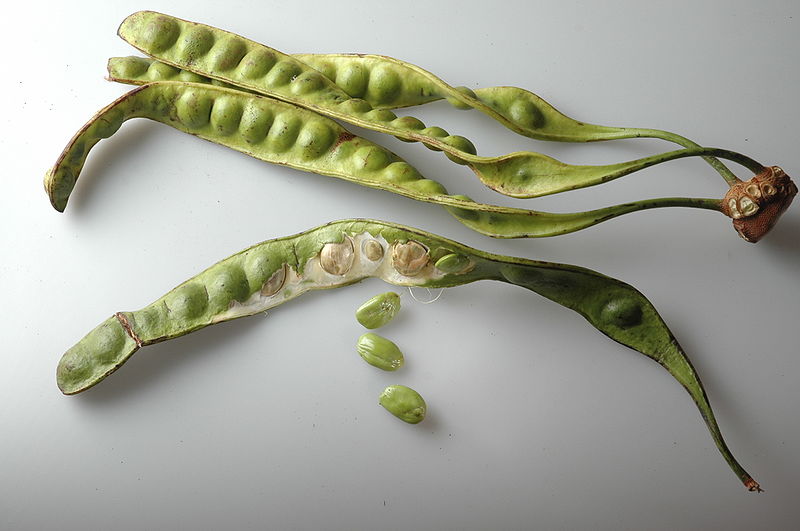Ever since I received the tempeh starter sent by a friend. I have been making tempeh at home. It is a good source of protein and is one of my favorite cooking ingredients back home. (You could now find tempeh at trader Joe's and wholefood, a good substitute to meat/fish!)
As my tempeh was growing at home, I saw frozen Petai/Stinking bean at the local Asian supermarket, it has been a long time since I have petai, I just couldn't resist bringing a packet home.
This Sambal tempeh petai is a very healthy and really satisfying dish!
自从朋友给我寄来丹贝黴菌之后我就经常在家自己做丹贝。丹贝是个非常好的植物蛋白质来源。刚好前几天在Hmart看见有泰国进口的臭豆(美丽球花豆/Petai/Power bean),是东南亚很特殊的一种食材。
臭豆之所以称为臭豆是因为它有一种特殊的气味,一般人可能不太容易习惯。但是臭豆的功效也是非常多的,还有降血糖的功效。今天做的这个丹贝臭豆叁巴,是东南亚很家常的一个素食食谱,下饭好吃。
The ingredients/食材介绍:

Tempeh (/ˈtɛmpeɪ/; Javanese: témpé, IPA: [tempe]), is a traditional soy product originally from Indonesia. It is made by a natural culturing and controlled fermentation process that binds soybeans into a cake form, similar to a very firm vegetarian burger patty. Tempeh is unique among major traditional soy foods in that it is the only one that did not originate in theSinosphere.
It originated in today's Indonesia, and is especially popular on the island of Java, where it is astaple source of protein. Like tofu, tempeh is made from soybeans, but it is a whole soybean product with different nutritional characteristics and textural qualities.[1] Tempeh's fermentation process and its retention of the whole bean give it a higher content of protein,dietary fiber, and vitamins. It has a firm texture and an earthy flavor which becomes more pronounced as it ages.[2][3] Because of its nutritional value, tempeh is used worldwide invegetarian cuisine; some consider it to be a meat analogue.
Source : http://en.wikipedia.org/wiki/Tempeh
丹貝(tempeh)发源于东南亚的印度尼西亚,是一种大豆/豆类发酵食品,又名天培/天贝。 传统的做法是把煮熟脱皮的大豆加入根黴属(Rhizopus spp.)真菌,用香蕉叶包裹,室温(30C/85F)左右发酵36-48个小时,成白色饼状豆制品.可以用来烹调成多种不同的美食,是天然的肉类代替品。 丹贝的蛋白质和氨基酸含量很高,有素食者的肉类的美称,丹贝含有的游离氨基酸为总氨基酸含量的76%,是大豆发酵前的6倍。除此之外,维生素B12的含量也很高,是大豆发酵前的60倍左右。

Parkia speciosa (bitter bean, twisted cluster bean, or stink bean) is a plant of the genus Parkia in the family Fabaceae. It bears long, flat edible beans with bright green seeds the size and shape of plump almonds which have a rather peculiar smell, characterised by some as being similar to natural gas.[1]
The beans or other Parkia species (Parkia javanica and Parkia singalaris for example) are popular as culinary ingredient in Indonesia, Malaysia, Singapore, Laos, southern Thailand, Burma, and northeasternIndia, and are sold in bunches, still in the pod, or the seeds are sold in plastic bags. Pods are gathered from the wild, or from cultivated trees: they are exported in jars or cans, pickled in brine, or frozen.
Source : http://en.wikipedia.org/wiki/Petai
臭豆(Petai)富含天然糖分:蔗糖、果糖和葡萄糖。这些糖分可增强体力。科研结果证明,仅仅两份臭豆,就足以抵挡90分钟的重体力活,所以那些头号体育明星们特别钟情臭豆食品。
此外,臭豆还有其它各种疗效呢!(注:资料来自各种渠道)
一、抗抑郁症 据MIND 研究证明,有许多抑郁症患者,服用臭豆以后,病情有所好转。因为臭豆含有色氨酸,一种蛋白质,能经人体转化为血清素,使人放松情绪、心情愉悦。
二、经前期综合症(PMS) 你如果经历经前期综合症的话,不用服用什么药片,吃臭豆就行了。富含维他命B6的Pete可以调整血液中的糖含量,从而调节情绪。
三、贫血症 富含铁质的臭豆有助于人体红血球的生成,改善贫血症。
四、高血压 臭豆这个含钾极高,含盐低的热带作物,是抗高血压的良药。美国食品及药物管理局(FDA)已正式批准种植,并公认其降压和预防脑中风的疗效。
五、 健脑 今年在Twickenham (Middlesex)的200名学生,早餐、中间课休时间和午餐时食用了臭豆,他们顺利通过了考试。科研证明,富含钾的果品有助于学习,使学生脑子更清醒。
六、 便秘 臭豆的纤维素含量很高,助消化,从而可解决便秘问题。
七、治眩晕臭豆奶昔加蜂蜜,是治疗眩晕症的方法之一。臭豆可宁胃,蜂蜜可增加血糖含量,而牛奶有镇静作用,并能恢复体内丢失的水分。
八、饱胀 臭豆在人体内具有抗酸剂作用,因食过饱而胃胀不适时,食用臭豆可缓解症状。
。。。。。。
十一、神经系统疾病 臭豆富含维生素V, 可对神经系统起到镇静作用。
十二、肥胖症 据奥地利心理研究院调查发现,工作压力大的人经常会吃一些诸如巧克力和土豆片之类去舒缓压力。从在医院就诊的5000名病人中调查发现,工作压力大会使人发胖。 因此,他们得出结论,为了避免因工作压力造成的食欲,必须控制血液中的含糖量,可采取每两个小时吃碳水化合物含量高的零食,使血糖保持平衡。
十三、胃炎 由于臭豆质地柔和,可作为一种养胃的食品。经好多严重胃炎病例证实臭豆是唯一可以生吃而没有造成不良效果的果品。它不仅能中和胃酸,还能增加胃表面涂层,以减少对胃的刺激。
资料来源:http://boansonnet.5d6d.net/thread-1844-1-1.html
Ingredients:
200 gm Tempeh
1-2 medium size of potatoes
100 gm/1 packet of frozen/ fresh stinking bean(petai)
1 lemon grass (Cut to 3-4 inches,lightly brush to release more fragrance)
1 cup of cooking oil
For Sambal paste:
10-12 or 30 gm of dried chili (or half fresh red chili and half dried red chili)
3-4 cloves of garlic
5-6 Shallot
50-60 gm Palm sugar/Gula Melaka or brown sugar
1 tsp Tamarind Paste or 8 gm of tamarind pulp (mix with 1/2 cup of hot water)
1/2 tsp Sweet/dark soy sauce
食谱:
材料:
200克 丹贝
1-2 只中型 土豆/马铃薯
100 克/一包 冷冻/新鲜臭豆(Petai)
1 根 新鲜香茅 (切成3-4寸,稍微拍拍)
1 杯 食油
叁巴酱材料:
10-12 根 或 30 克左右的 辣椒干 (如果买得到新鲜的红辣椒用一半的红辣椒取代辣椒干,颜色会更好看)
3-4 瓣 蒜瓣
5-6 只 红葱 (Shallot)
50-60 克 椰糖 (Palm sugar/Gula Melaka)或用红糖代替
1 tsp 罗望子酱 (Tamarind Paste)或大约 8 克的罗望子膏 (兑1 杯热水)
1/2 tsp 黑酱油/甜酱油/酱油膏(老抽代替也可)
1. Soak dried chili in hot water for about 8-10 minutes, drained. Cut and brush the lemon grass lightly. Peel the potato, cubed/sliced potato and Tempeh into thin slices/cubes.
2. Heat about 1 cup of oil in cooking pan and deep fry potato and Tempeh pieces into golden brown in color, drain and set aside.
3. Blend Chili, shallot and garlic into paste. Heat about 2 tbsp of oil in cooking pan, add lemongrass and chili paste and cook until the oil separated at the edge. Add palm sugar/gula Melaka and crush the palm sugar using spatula, cook until dissolved.
4. Add tamarind water and Petai, bring to boil and season with sweet soy sauce and salt, continue cooking until the gravy thickened, add fried potato and tempeh, turn well until all coated with sambal sauce.
Serve with steamed white rice.
1. 把材料都准备好,辣椒干泡热水变软。香茅切断拍拍,土豆去皮切薄片/小块,丹贝切薄片/小块。
2. 起油锅,把土豆和丹贝炸成金黄色沥干备用。如果想要更健康一些也可以喷点油烤箱里烤脆。
3. 把辣椒干,红葱和蒜瓣用搅拌机搅拌成辣椒糊。锅里热上 2 大勺油,把香茅和辣椒糊一起下锅煸炒出香味,加入椰糖,煮溶。
4. 加入臭豆和罗望子汁煮滚,加黑酱油/甜酱油和盐调味。继续煮大约5分钟至浓稠之后,加入土豆和丹贝片,翻匀即可上桌。
香辣下饭的丹贝臭豆叁巴



More rice please, sound so yummy!
ReplyDeletecoming!!!
ReplyDelete